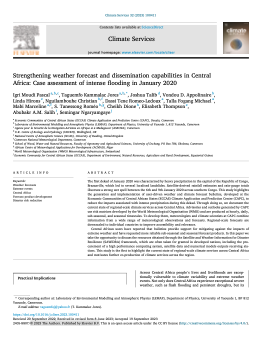
Read the full article here
Abstract
The first decade of January 2020 was characterised by heavy precipitation in the capital of the Republic of Congo, Brazzaville, which led to several localised landslides. Satellite-derived rainfall estimates and rain-gauge totals illustrate a strong wet spell between the 6th and 9th of January 2020 across southern Congo. This study highlights the generation and implementation of user-driven weather and climate forecast bulletins, developed at the Economic Communities of Central African States (ECCAS) Climate Application and Prediction Centre (CAPC), to reduce the impacts associated with intense precipitation during this decade. Through doing so, we document the current state of regional-scale climate services across Central Africa. Advisories and outlooks generated by CAPC use risk matrices developed by the World Meteorological Organisation (WMO) and are produced at hourly, daily, sub-seasonal, and seasonal timescales. To develop them, meteorologists and climate scientists at CAPC combine information from a wide range of meteorological observations and forecasts. Regional-scale forecasts are downscaled to individual countries to improve accessibility and relevance.
Central African users have reported that bulletins provide support for mitigating the impacts of extreme weather and have requested more reliable sub-seasonal and seasonal forecast products. In this paper, we take the opportunity to discuss the resources obtained through the Satellite and Weather Information for Disaster Resilience (SAWIDRA) framework, which are often taken for granted in developed nations, including the procurement of a high-performance computing system, satellite data and numerical models outputs receiving stations. This study is the first to highlight the current state of regional-scale climate services across Central Africa and motivates further co-production of climate services across the region.